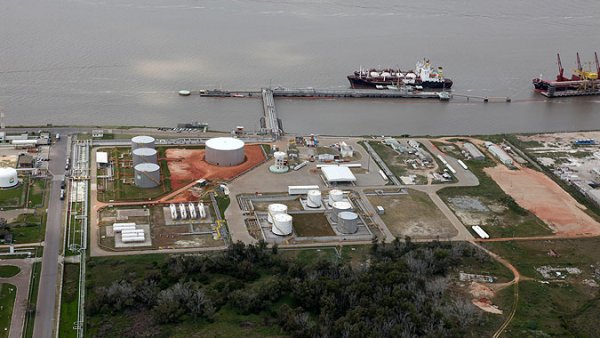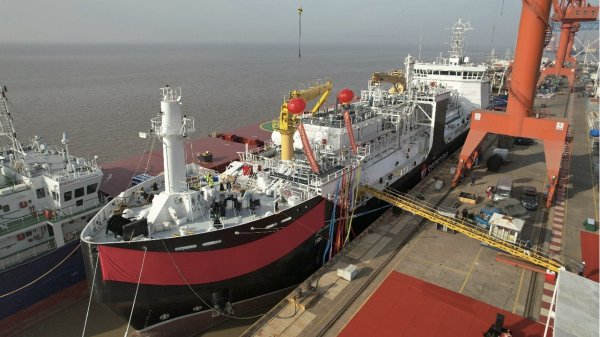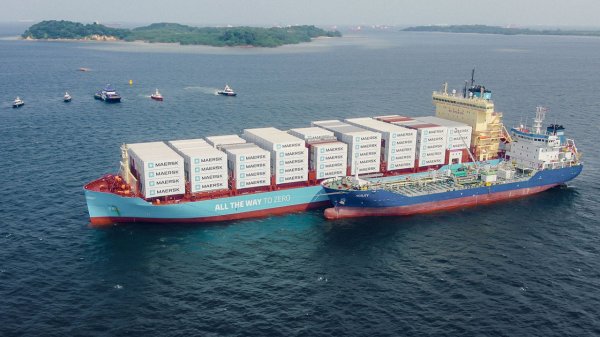Horizon's Q1 bunker costs decline by $37 per tonne
Average fuel costs decline by 5.5% in the first quarter compared to the previous year.
U.S. ocean shipping company Horizon Lines, Inc. has confirmed that its average bunker costs decreased during the first quarter of 2014 in comparison with the corresponding period the previous year.
Vessel fuel costs averaged $638 per metric tonne in the first quarter, down $37 per tonne, or 5.5%, on the average price of $675 per tonne recorded for the same quarter in 2013.
The fuel data was revealed this week by Horizon Lines, Hawaii's second largest ocean shipper, in its results for the fiscal first quarter ended March 23, 2014.
First Quarter 2013 Results
On a GAAP basis, the first-quarter net loss from continuing operations totaled $26.3 million, or $0.66 per share, on a weighted average of 39.9 million basic and fully diluted shares outstanding. This compares with year-ago net loss of $20.1 million, or $0.58 per share, based on a weighted average of 34.7 million basic and fully diluted shares outstanding. On an adjusted basis, the first-quarter net loss from continuing operations totaled $24.1 million, or $0.60 per share, compared with an adjusted net loss of $14.5 million, or $0.42 per share, a year ago. The 2014 and 2013 first-quarter net losses reflect the same items impacting adjusted EBITDA. Additionally, the adjusted net loss for both periods excludes the non-cash accretion of payments associated with certain legal settlements, and includes the tax impact of the adjustments.
EBITDA from continuing operations totaled $4.9 million for the 2014 first quarter, compared with $8.4 million for the same period a year ago. Adjusted EBITDA from continuing operations for the first quarter of 2014 was $6.8 million versus $13.7 million for 2013. EBITDA and adjusted EBITDA for the 2014 and 2013 first quarters were impacted by the same factors affecting operating loss. Additionally, 2014 and 2013 first quarter adjusted EBITDA reflect the exclusion of $71 thousand and $45 thousand, respectively, of non-cash gains on marking the conversion feature in the company’s convertible debt to fair value.
The GAAP operating loss from continuing operations for the first quarter totaled $8.6 million, compared with an operating loss of $4.3 million a year ago. The $4.3 million decline was mainly due to higher fuel and labor costs associated with dry-docking transits and contractual cost increases that impacted marine, inland transportation and terminal expenses. The 2014 first-quarter GAAP operating loss includes charges totaling $1.9 million associated with employee severance and certain legal expenses. The 2013 first-quarter GAAP operating loss includes $5.4 million of costs associated with a restructuring charge, employee severance, and certain legal expenses. Adjusting for these items, the first-quarter 2014 adjusted operating loss from continuing operations totaled $6.6 million, compared with adjusted operating income of $1.1 million a year ago.
First-quarter operating revenue from continuing operations grew 3.0% to $251.9 million from $244.5 million a year ago. The factors driving the $7.4 million revenue improvement were a $12.9 million volume increase – driven by higher volumes in the Hawaii market, the addition of a bi-weekly Jacksonville sailing to the southbound service between Houston and San Juan, and market share gains in the service between Philadelphia and San Juan – and a $0.2 million rise in non-transportation services revenue. These were partially offset by a $3.3 million decrease in container revenue rates and a $2.4 million drop in bunker and intermodal fuel surcharges.
Container volume for the 2014 first quarter totaled 55,223 revenue loads, up 7.6% from 51,321 loads for the same period a year ago. The increase was primarily due to improved volumes in the Hawaii and Puerto Rico markets, partially offset by a decline in volumes in the Alaska market. Unit revenue per container totaled $4,197 in the 2014 first quarter, compared with $4,363 a year ago. First-quarter unit revenue per container, net of fuel surcharges, was $3,221, down 2.0% from $3,286 a year ago.
Commenting on the results, Sam Woodward, President and Chief Executive Officer, said: "Horizon Lines generated 7.6% higher revenue container volume over the same period a year ago, driven largely by volume increases in our Hawaii and Puerto Rico trade lanes, which were partially offset by lower volumes in our Alaska market. Volume increases in our Hawaii market were predominantly due to modest growth in the Hawaii economy, including construction materials and tourism, as well as an increase in automobile shipments. Improvement in our Puerto Rico lift was primarily due to the full quarter impact of 2013’s addition of a biweekly Jacksonville sailing to our southbound service between Houston and San Juan, as well as market share gains in our service between Philadelphia and San Juan.
"The 3.0% improvement in operating revenue over the same period a year ago was due to the higher revenue container volume, which was partially offset by a 3.8% decrease in average unit revenue,” Mr. Woodward said. “The decline in our container rates was mainly due to lower bunker and intermodal fuel surcharges, the competitive environment in the Puerto Rico market, and a shift in cargo mix. The adjusted EBITDA shortfall of $6.9 million from a year ago was primarily due to a $6.9 million increase in fuel and labor costs associated with vessel dry-docking transits. Lower rates, net of fuel and contractual cost increases were offset by higher volumes and the elimination of vessel lease expense due to the purchase of the D7 vessels in January 2013.”
2014 Outlook
In its outlook for 2014, Horizon Lines said: "We expect 2014 revenue container loads to be above 2013 levels due to anticipated modest volume growth in all three markets we serve. This projected volume growth takes into consideration the estimated impacts of a new competitor that entered the Puerto Rico Gulf service in May 2013, as well as a second vessel being added by a competitor in our Hawaii service during the fourth quarter of 2014, partially offset by the full-year impact of adding a bi-weekly Jacksonville sailing to our southbound service between Houston, Texas and San Juan, Puerto Rico.
"Overall, container rates are expected to be below 2013 levels due to very competitive market conditions and a slight change in cargo mix. The new vessel capacity added in Puerto Rico in 2013 and expected to be added in Hawaii in 2014 will continue to impact rates as well.
"We will experience increases in expenses associated with our revenue container volumes, including our vessel payroll costs and benefits, stevedoring, port charges, wharfage, inland transportation costs, and rolling stock costs, among others. Although the number of vessels being dry-docked in 2014 is less than 2013, the costs associated with repositioning vessels and expenses related to spare vessels will slightly exceed 2013 levels.
"We expect 2014 financial results to approximate 2013 results, with 2014 adjusted EBITDA projected between $85.0 million and $95.0 million, compared with $95.2 million in fiscal 2013.
"Based on our current level of operations, we believe cash flow from operations and borrowings available under the ABL Facility will be adequate to support our business plans. We expect total liquidity during 2014 to reach a low of approximately $35.0 million during the second quarter, then build over the balance of the year and end 2014 at approximately $70.0 million."
Vessel fuel costs averaged $638 per metric tonne in the first quarter, down $37 per tonne, or 5.5%, on the average price of $675 per tonne recorded for the same quarter in 2013.
The fuel data was revealed this week by Horizon Lines, Hawaii's second largest ocean shipper, in its results for the fiscal first quarter ended March 23, 2014.
First Quarter 2013 Results
On a GAAP basis, the first-quarter net loss from continuing operations totaled $26.3 million, or $0.66 per share, on a weighted average of 39.9 million basic and fully diluted shares outstanding. This compares with year-ago net loss of $20.1 million, or $0.58 per share, based on a weighted average of 34.7 million basic and fully diluted shares outstanding. On an adjusted basis, the first-quarter net loss from continuing operations totaled $24.1 million, or $0.60 per share, compared with an adjusted net loss of $14.5 million, or $0.42 per share, a year ago. The 2014 and 2013 first-quarter net losses reflect the same items impacting adjusted EBITDA. Additionally, the adjusted net loss for both periods excludes the non-cash accretion of payments associated with certain legal settlements, and includes the tax impact of the adjustments.
EBITDA from continuing operations totaled $4.9 million for the 2014 first quarter, compared with $8.4 million for the same period a year ago. Adjusted EBITDA from continuing operations for the first quarter of 2014 was $6.8 million versus $13.7 million for 2013. EBITDA and adjusted EBITDA for the 2014 and 2013 first quarters were impacted by the same factors affecting operating loss. Additionally, 2014 and 2013 first quarter adjusted EBITDA reflect the exclusion of $71 thousand and $45 thousand, respectively, of non-cash gains on marking the conversion feature in the company’s convertible debt to fair value.
The GAAP operating loss from continuing operations for the first quarter totaled $8.6 million, compared with an operating loss of $4.3 million a year ago. The $4.3 million decline was mainly due to higher fuel and labor costs associated with dry-docking transits and contractual cost increases that impacted marine, inland transportation and terminal expenses. The 2014 first-quarter GAAP operating loss includes charges totaling $1.9 million associated with employee severance and certain legal expenses. The 2013 first-quarter GAAP operating loss includes $5.4 million of costs associated with a restructuring charge, employee severance, and certain legal expenses. Adjusting for these items, the first-quarter 2014 adjusted operating loss from continuing operations totaled $6.6 million, compared with adjusted operating income of $1.1 million a year ago.
First-quarter operating revenue from continuing operations grew 3.0% to $251.9 million from $244.5 million a year ago. The factors driving the $7.4 million revenue improvement were a $12.9 million volume increase – driven by higher volumes in the Hawaii market, the addition of a bi-weekly Jacksonville sailing to the southbound service between Houston and San Juan, and market share gains in the service between Philadelphia and San Juan – and a $0.2 million rise in non-transportation services revenue. These were partially offset by a $3.3 million decrease in container revenue rates and a $2.4 million drop in bunker and intermodal fuel surcharges.
Container volume for the 2014 first quarter totaled 55,223 revenue loads, up 7.6% from 51,321 loads for the same period a year ago. The increase was primarily due to improved volumes in the Hawaii and Puerto Rico markets, partially offset by a decline in volumes in the Alaska market. Unit revenue per container totaled $4,197 in the 2014 first quarter, compared with $4,363 a year ago. First-quarter unit revenue per container, net of fuel surcharges, was $3,221, down 2.0% from $3,286 a year ago.
Commenting on the results, Sam Woodward, President and Chief Executive Officer, said: "Horizon Lines generated 7.6% higher revenue container volume over the same period a year ago, driven largely by volume increases in our Hawaii and Puerto Rico trade lanes, which were partially offset by lower volumes in our Alaska market. Volume increases in our Hawaii market were predominantly due to modest growth in the Hawaii economy, including construction materials and tourism, as well as an increase in automobile shipments. Improvement in our Puerto Rico lift was primarily due to the full quarter impact of 2013’s addition of a biweekly Jacksonville sailing to our southbound service between Houston and San Juan, as well as market share gains in our service between Philadelphia and San Juan.
"The 3.0% improvement in operating revenue over the same period a year ago was due to the higher revenue container volume, which was partially offset by a 3.8% decrease in average unit revenue,” Mr. Woodward said. “The decline in our container rates was mainly due to lower bunker and intermodal fuel surcharges, the competitive environment in the Puerto Rico market, and a shift in cargo mix. The adjusted EBITDA shortfall of $6.9 million from a year ago was primarily due to a $6.9 million increase in fuel and labor costs associated with vessel dry-docking transits. Lower rates, net of fuel and contractual cost increases were offset by higher volumes and the elimination of vessel lease expense due to the purchase of the D7 vessels in January 2013.”
2014 Outlook
In its outlook for 2014, Horizon Lines said: "We expect 2014 revenue container loads to be above 2013 levels due to anticipated modest volume growth in all three markets we serve. This projected volume growth takes into consideration the estimated impacts of a new competitor that entered the Puerto Rico Gulf service in May 2013, as well as a second vessel being added by a competitor in our Hawaii service during the fourth quarter of 2014, partially offset by the full-year impact of adding a bi-weekly Jacksonville sailing to our southbound service between Houston, Texas and San Juan, Puerto Rico.
"Overall, container rates are expected to be below 2013 levels due to very competitive market conditions and a slight change in cargo mix. The new vessel capacity added in Puerto Rico in 2013 and expected to be added in Hawaii in 2014 will continue to impact rates as well.
"We will experience increases in expenses associated with our revenue container volumes, including our vessel payroll costs and benefits, stevedoring, port charges, wharfage, inland transportation costs, and rolling stock costs, among others. Although the number of vessels being dry-docked in 2014 is less than 2013, the costs associated with repositioning vessels and expenses related to spare vessels will slightly exceed 2013 levels.
"We expect 2014 financial results to approximate 2013 results, with 2014 adjusted EBITDA projected between $85.0 million and $95.0 million, compared with $95.2 million in fiscal 2013.
"Based on our current level of operations, we believe cash flow from operations and borrowings available under the ABL Facility will be adequate to support our business plans. We expect total liquidity during 2014 to reach a low of approximately $35.0 million during the second quarter, then build over the balance of the year and end 2014 at approximately $70.0 million."

|
VARO Energy expands renewable portfolio with Preem acquisition
All-cash transaction expected to complete in the latter half of 2025. |
|
|
|
||

|
NYK trials biofuel in milestone coal carrier test
Vessel is used to test biofuel for domestic utility company. |
|
|
|
||

|
H-Line Shipping orders LNG bunkering vessel
Vessel with 18,000-cbm capacity to run on both LNG and MDO. |
|
|
|
||

|
How to engineer and manage green shipping fuels | Stanley George, VPS
Effective management strategies and insights for evolving fuel use. |
|
|
|
||

|
Swedish government bans scrubber wastewater discharges
Discharges from open-loop scrubbers to be prohibited in Swedish waters from July 2025. |
|
|
|
||

|
MAN Energy Solutions achieves 100% load milestone for ammonia engine
Latest tests validate fuel injection system throughout the entire load curve. |
|
|
|
||

|
Petrobras secures ISCC EU RED certification for B24 biofuel blend at Rio Grande
Blend consisting of 24% FAME is said to have been rigorously tested to meet international standards. |
|
|
|
||

|
Stolt-Nielsen to fully control Avenir LNG with acquisition
Share purchase agreement to buy all shares from Golar LNG and Aequitas. |
|
|
|
||

|
Bureau Veritas supports launch of CIMC SOE's LNG bunkering vessel
Handover of Seaspan Energy's cutting-edge 7,600-cbm vessel completed. |
|
|
|
||

|
Methanol as a marine fuel | Steve Bee, VPS
How environmental legislation has driven the development of low-sulphur fuels and methanol-ready ships. |
|
|
|
||
Related Links
- · Horizon's fuel costs fall $49 per tonne in Q4 2013 [Insights]
- · Horizon Lines to convert vessels to burn LNG [Insights]
- · Shipper announces drop in bunker costs [Insights]
- · Horizon Lines lowers fuel surcharge [Insights]
- · United States [Directory]

